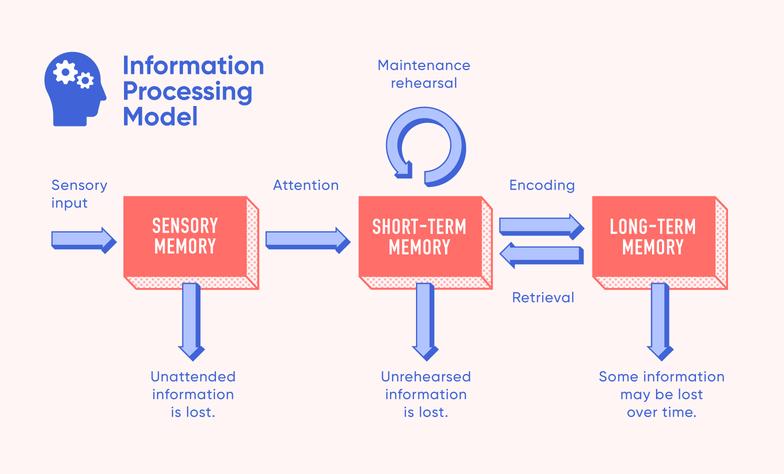Introduction
CognitiveInformationProcessingTheorybelievesthatcareerdevelopmentistoseehowapersonmakescareerdecisionsandhowtousethemintheprocessofcareerproblemsolvingandcareerdecision-makinginformational.
In1991,GaryPeterson,JamesSampson,RobertReardonco-authored"CareerDevelopmentandService:AKindThebook"CareerDevelopmentandServices:ACognitiveApproach"describesthismethodofcognitiveinformationprocessing(CIP).
HypothesisofInformationProcessingTheory
Almostallinformationprocessingtheoristsbelievethatlearningisessentiallyconstitutedbytheacquisitionanduseofinformation.Oneoftheirbasicassumptionsisthatbehaviorisdeterminedbytheinformationflowwithintheorganism.Sincethiskindofinformationflowisjustaconjecture,itcanneverbedirectlyobserved.Therefore,psychologistshaveconstructeddifferentmodelstoderivethisinformationflow;itdependsonwhichinternalprocessthetheoristwantstoexplain.Perhaps,manyoftheinformationflowdiagramstochoosefromaretenable.Butingeneral,informationprocessingtheoristsaremainlyconcernedwithtwoissues:(1)thenatureofthehumanmemorysystem;(2)thewayinwhichknowledgeisrepresentedandstoredinthememorysystem.
Classificationofinformationprocessingtheory
Researchandstudyfromtheperspectiveofinformationprocessing,startingfromdifferentsources.Somepeoplethink(Ellis,1978),itisinfluencedbytheGestaltmemorytheory,whichemphasizesthathoworganismsorganizethecontentoftheirmemoriesreflectshowtheyactivelyorganizeperceptions.Somepeople(Norman,1970)distinguishedthreetheoriesthathaveanimpactontoday'sinformationprocessingtheory:(1)MathematicallearningtheoriesfirstproposedbyEstesandSpence;(2)(3)Emphasizesthesignaldetectiontheorieswithselectiveattentionasthestartingpointandlong-termmemorytracesastheend;(3)Computer-modeltheorieswithemphasisonartificialintelligenceandcomputersimulation.
AccordingtoG.E.Snelbecker'spointofview,currently,whatisconsideredtobewithinthescopeofinformationprocessingtheorycanberoughlydividedintothefollowingthreecategories:
1.FocusonInformationtheoryinmathematicalstatisticalanalysis
TheAmericanscholarC.Shannonisrecognizedasthefatherofinformationtheory.AsatechnicianofBellTelephoneCompany,Shannonhasprocessedinformationmathematicallyintheresearchprocessinordertosolvetheproblemofinformationcodingandimprovetheefficiencyandreliabilityofthecommunicationsystem.Hediscardsthespecificcontentofthemessageinthecommunicationsystem,andtreatstheinformationgeneratedbytheinformationsourceasonlyanabstractquantity.Heappliedmathematicalstatisticstothefieldofcommunication,putforwardthemathematicalformulaofinformationentropy,describedtheproblemofinformationtransmissionandextractionintermsofquantity,andputforwardtheconceptofinformationquantity.Hedesignedasetofmethodstomeasureinformationundervariousconditions,thuslayingthefoundationofmoderninformationtheory(WangYutian,1986).
Toputitsimply,Shannon’smeasurementfocusesonthesimilaritybetweentransmittedandreceivedmessagesinordertocalculatehowmuchinformationthesenderandreceivercanget.Shannonregardstheexchangeofmessagesasacharacteristicofcommunication.Therefore,informationtheoryisconcernedwiththeimpactofmessagesthatmayhavebeendelivered,aswellasthesignalsthatareactuallydelivered.
PsychologistsadaptedShannon’sinformationmeasurementandtheory.Thestimulipresentedtothesubjectscorrespondedtothesourceandtransmitteroftheinformationinthecommunicationsystem.Thechannelisregardedasthecharacteristicofthehumansubject;thesubject'smaximumaccuracyinencodingthesignalandmakingthecorrectresponseiscalledhischannelcapacity.
Informationanalysisfocusesontheconsistencyoftheparticipants’responsestothestimulipresentedinaseriesofattempts.Forexample,wecanpresentfourtoneswithdifferenttimbresbutthesameinotheraspects(suchassoundandduration),andaskthemtomakefourdifferentresponses.Inthisway,wecandeterminewithoutdetailedcalculations.Didtheparticipantprocessalltheinformationavailableinthissituation?

Whenadultsubjectsarepresentedwithasingle-dimensionalstimulus(thatis,exceptforonestimuluswithadifferentdimension,allotheraspectsareexactlythesame),therewillbeaninterestingphenomenon.Oncethesubjectshadenoughpracticetoclearlyknowhowtorespondtoeachstimulus,theiraccuracyreachedtenasymptoticlines,andtheymaintainedaccuracyduringoperation.Moreover,evenifthestimulusisonlyperceivedthroughdifferentsensorychannels,orthearrangementofthestimuliisdifferent,thechangeinthenumberofstimulithatcanbecorrectlyidentifiedisverysmall.In1956,G.Millerpublishedanarticleentitled:"TheMagicalNumberSeven,PlusOrMinusTwo:SomeLimitsonOurInformationProcessingEnergy"(TheMagicalNumberSeven,PlusOrMinusTwo:SomeLimitsonOurCapacityforProcessinginformation)",hereviewednearly20studiesandfoundthattheenergyofhumanstoprocessinformationislimited.Millerproposedthatweshouldusegoldinsteadofwastetofillthesesevenorsomemoryholes.AfterMiller'sarticlewaspublished,psychologistsengagedinhundredsofsuchstudies.Althoughsomepeoplehavequestionsaboutthecalculationprocedureofhumanchannelenergy,manypsychologistshaveacceptedthisdiscovery,whichhasacertainimpactonthestudyoflearningandmemory.Therearealsopeoplewhothinkfromanotherperspectivethatwecanorganizeinformationinto"chunks,"whichcanincreasehumaninformationprocessingcapabilities.Therefore,weshouldfocusonthewaypeopleorganizeinformation.
Generallyspeaking,psychologistsbelievethatinformationtheoryhelpsusformamodelofhumansasinformationprocessors.Thismodelemphasizestheroleofactivechoiceswhenpeoplerespondtostimuli,ratherthanthepassiveroleofpeopleasseeninthestimulus-responsetheory.Atthesametime,somepeoplethink(Simon,1979)thatfocusingresearchonnarrowlaboratoryanalysisisnotveryhelpfultounderstandingtheprocessofhumanproblemsolving.
2.Informationprocessingtheoryfocusingoncomputersimulation
Theconceptoftreatingpeopleasinformationprocessorsislinkedtothedevelopmentofcomputertechnology.ComputertechnologywasdevelopedduringtheSecondWorldWar,mainlybecauseoftheprocessingoflargeamountsofmilitarydata.Psychologistshavediscoveredthatcomputerprogramscanalsobeusedtodescribethewayhumansthinkandlearn.Someresearchersusecomputerstosimulatehumanproblemsolvingandlearningprocesses.Inthisway,psychologistsnolongerjustspeculateaboutwhatishappeninginsidethe"blackbox."
Therearetwomaindevelopmentsregardingcomputersandhumaninformationprocessing:Ontheonehand,althoughmanyinformationtheoristsarenotinterestedinhumancognitiveprocesses,theyareveryconcernedaboutimprovingthewaycomputersprocessinformation.Therefore,theycanusethehumanthoughtprocessasaguidetoimprovethecomputer'sdataprocessingprogram.Therefore,thetermartificialintelligence(artificialintelligence)isoftenonlyusedtorefertotheinformationprocessingstepsfollowedbythecomputer,regardlessofwhetherthesestepssimulatetheactualwayhumansprocessinformation,whichisnotthesameasthetermitself.Themeaningofiscontradictory(Simon,1969).Oneofthemostpracticalgoalsinartificialintelligenceistofindthebestwayforcomputerstostore,extract,perform,anduseinformation.Asforwhetherhumansfollowthesestepswhensolvingproblems,thisisnotwhattheycareabout.
Butotherscholars’interestincomputerprocessingfocusesonsimulatingtheprocessofhumanproblemsolving.Computersimulation(computersimulation)usuallyreferstothemethodusedwhenusingcomputersandcomputerlanguagestodescribetheprocessofhumaninformationprocessing.ThemosttypicalcharacterinthisregardisSimon.Hebelievesthatthereisaone-to-onecorrespondencebetweenhumancognitiveactivitiesandcomputers.
ThefirstsuccessfulcomputersimulationofhumanthinkingwasdesignedbyNewellandSimon.Thisprogramiscalledthe"LogicTheorist"programandcanbeusedtoprovevarioustheoremsinformallogic."Logictheorists"haveadoptedsomeoftheprocessingmethodsusedbyhumansinproblem-solvingactivities,buttheycanonlysolvecertaintypesofproblems.NewellandSimondesignedamoresophisticatedproblem-solvingsystemin1972,calledthe"GeneralProblemSolver".Thisprogramcombinesalargenumberofstrategiesthatarebelievedtobethebasisofhumanproblem-solvingactivities.Thisprogramcannotonlyprovelogicaltheorems,butalsoplaychessandcomposemusic.Asaresult,theyproposedabasicstructureinvolvedinproblem-solvingbehavior,whichtheycalledan"informationprocessingsystem"or"IPS".Thereceptivesystem(orreceptor,thatis,thenerveendingsandthechannelsthattransmitsensationstothebrain)oftheproblemsolverisconnectedtotheinformationprocessor,andtheinformationprocessorneedstousememory.Memoryalsoprovidesinformationforinformationprocessors,andinformationprocessorsprovideinformationforeffectors.Effectorreferstotheactionprocessofimplementingthedecisionintheprocessofproblemsolving.
3.Cognitiveinformationprocessingtheoryfocusingonpracticalapplications
Theproblemofresearchmethodshasalwaysbeenaverydifficultprobleminpsychologicalresearch.Informationprocessingcognitivepsychologyinheritsthetraditionofexperimentalpsychology,absorbstheresearchresultsofcomputerscience,andformsarelativelycompleteresearchmethod—aresearchmethodthatcombinesexperiment,simulation,andtheoreticalanalysis.Thisresearchmethodfullyreflectsthehighlycomprehensiveresearchcharacteristicsofcontemporaryscienceonthebasisofexperiments,aswellasthecombinationofqualitativeresearchandquantitativeresearch,andthecombinationofmacroscopicresearchandmicroscopicresearch.Itisthebreakthroughinresearchmethodsthatpromotesthedevelopmentofinformationprocessingcognitivepsychology.Theseresearchmethodsinclude:
(1)Experimentalmethod
SinceWundtestablishedthefirstpsychologylaboratoryinLeipzigmorethanonehundredyearsago,experimentalmethodshavebeenwidelyused.Acceptedbymostpsychologists.Thisisbecausetheexperimentalmethodenablesresearcherstosystematicallymanipulateindependentvariables,observechangesindependentvariables,andexploretherelationshipbetweenvariablesinacontrolledsituation.Experimentshelpresearcherstocollectdata,verifyhypotheses,andimprovethereliabilityandvalidityofpricestudies.Experimentalmethodisthemainmethodusedbyinformationpluscognitivepsychology.
Theexperimentsofinformationprocessingcognitivepsychologyaremainlyreactiontimeexperimentsandeyemovementexperiments.
(2)Oralreportmethod
Oralreportmethod,alsocalledthinkingaloud,isamethodwhereparticipantsreportaloudtheirthoughtswhenperforminganoperationExploremethodsofinternalcognitiveprocesses.Oralreportsaremostlycarriedoutduringoperation,buttheycanalsobenarratedthroughrecallafteroperation.Inasense,themethodoforalreportingissomewhatsimilartothetraditionalintrospectionmethod,anditcanalsoberegardedasacritiqueandinheritanceoftheintrospectionmethod.Whenconductinganoralreportexperiment,theexaminermustaskthesubjectstoreportthedetailedcontentoftheirthinkingduringtheoperationaloudandtruthfully,sothattheinternalthinkingprocessisexternallyverbal,buttheyarenotrequiredtoexplainthesituationorthinkingprocess.Whatthesubjectsreportedshouldmainlybetheinformationretainedinshort-termmemorythatwillsoondisappear.Usingthismethod,Naxen,Simonandothershavemadecertainachievementsincognitiveresearch.Theoralreportmethodhasbeenacceptedbymanyinformationprocessingcognitivepsychologists.
(3)Computersimulationmethod
Computersimulationisthemostrepresentativeanduniqueresearchmethodofinformationprocessingcognitivepsychology.Computersimulationistheintersectionofpsychologyandcomputerscience,anditisalsoanimportantpartofartificialintelligence.Thismethodistounderstandtheperson'spsychologicalprocessitselfthroughcomputersimulationofthepsychologicalprocess,thatis,toconductalogicalanalysisoftheperson'sinternalinformationprocessingprocess.
Computersimulationisoftencombinedwiththeoreticalanalysis,startingfromthreeaspects:programreduction,processanalysis,andprogramsimulation.Programreductionisamethodthatusespotentialfactorsasasourceofdataandseparatescognitivefactorstoexplorecognitiveprocesses.Thetypicaldesignistoallowsubjectstoperformtwotaskswithdifferentlevelsofcomplexity,andexploretheoperationtimeandinformationprocessingprocessofcomplextasksfromacomparativeperspective.Processanalysisistofurtherexplorethesequenceanddirectionofmentalrepresentationsduringoperationthroughthecomparisonofcomputerflowcharts.Programsimulationistocompilethehumancognitiveprocessintovariouscomputerlanguagesandinputitintothecomputer.Iftheinputprogramcanworknormally,thedesignercanatleastknowthatacertainmentalprocessislogicallyfeasible,thatis,toobtainlogicalrationality.verify.Forexample,Clarketal.usedcomputersimulationmethodstoexploretheprocessofhumansentencecomprehension,andDakoetal.exploredhowpeopleusetheirlimitedshort-termmemorytoprocessandanalyzethecontextofsentences.Thesestudieshaveachievedcertainresults.Achievement.
